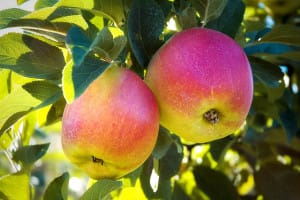Rodale’s Organic Life
by Rowan Jacobsen
 |
Look for these revived varieties that surely blow Red Delicious away.
On a steamy evening this July, John Bunker and his wife, Cammy Watts, padded down into the root cellar at their organic farm in Maine and rustled through a collection of wooden bins until they found what they were after: six purple-skinned, white-freckled apples, which had spent the past eight months sitting in repose in the cool darkness. The couple turned a pair of the Black Oxfords over in their hands, then cut one of them into quarters and bit into the crisp pieces. They agreed that the fruit was still delicious—not to be confused with Delicious, as in Red Delicious, the most ubiquitous apple variety in the United States. Left to sit that long, a Red Delicious apple and the rest of its supermarket ilk would have long ago turned to mush.
The Black Oxford, a 225-year-old variety famous for its longevity, is one of the dozens of idiosyncratic fruits that Bunker and Watts deliver to members of Out on a Limb, their community-supported agriculture operation. Every two weeks throughout fall, members receive 10 to 12 pounds of rare apples sourced from heritage and organic orchards in Maine. Some are meant for eating fresh. Some make great cider. Some, the silkiest applesauce. Some have the snap for a stupendous pie. And all it takes is a taste of one of those pies to understand what we’ve been missing.
A little backstory helps: Left to their own devices, apple trees crossbreed constantly; every seed has the potential to be a new variety. From the 1600s through the 1800s, apple culture flowered across America; settlers planted them everywhere for pies, preserves, and booze. As they discovered great new apples, farmers grafted shoots, creating regional favorites. The South had its burgundy-hued Arkansas Blacks. California was sweet-tart Gravenstein country. The Midwest was home to massive Wolf Rivers. And Boston markets were filled with acidic, sandpaper-skinned Roxbury Russets.
Then the 20th century came along. Supermarkets wanted cheaper apples, bred for long-distance shipping in eastern Washington’s industrial-scale orchards. Red Delicious was the Sylvester Stallone of the era, with glossy skin so thick it could withstand even the roughest transport and still look good. By the 1980s, three out of four apples grown in the United States were Red Delicious. Many great varieties were forgotten—especially ones good for baking.
Thankfully, though, the great old apples didn’t disappear. Anywhere the old farms escaped the bulldozer, you can still find them. All it takes is one old tree, from which you can graft endless new ones. Tracking down those aged arbors has been John Bunker’s lifetime pursuit. He peruses antique nursery catalogs, looking for hints as to where heirloom varieties thrived. He interviews nonagenarians. He hangs wanted posters for apples in general stores and post offices. When he finds a promising tree, he snips off a shoot and grafts it onto the living rootstock of another one. In this way, he says, he has saved 90 varieties from extinction.
In 2009, Bunker and his wife started their CSA. The couple figured that if they could get the heirlooms into people’s hands—and mouths—then they might create new demand. So far, so good. “We started with 50 members, and now we’re up to 150, and we have to turn people away every year.”
Apple CSAs have caught on in Michigan, Pennsylvania, Colorado, Vermont, and elsewhere. But the heirloom fever stretches far beyond community-supported agriculture—it has even reached eastern Washington.
Craig Campbell, one of the first big Washington growers to transition to organic cultivation, is now planting heirlooms as fast as he can at Harmony Orchards. “Last year, Whole Foods came in and bought every apple we had,” he says. “These heirlooms have so much going on that my wife says she’ll never make another pie from anything else.”
With their homespun looks and intense flavors, heirlooms can command higher prices, and they easily set themselves apart in the produce aisle. That makes them attractive to retailers. Now, shoppers are discovering this diversity of apples in the very same place it began to disappear: at the supermarket.
“It’s even infected the metropolises,” says Bunker, who recently visited Wassail, a new hard-cider bar on New York City’s Lower East Side. When he opened the menu, he was amazed to see a drink called a Black Oxford. “No one had ever heard of this apple twenty years ago, and now it’s a signature cocktail,” he says. It was abundantly clear to Bunker as he lifted his glass: The heirloom revolution has officially taken off—it’s as vibrant in Manhattan as it is in Maine.

